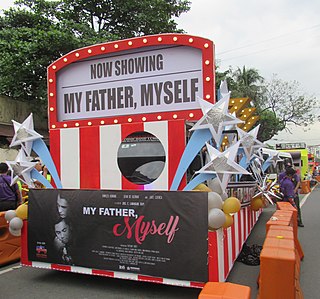Related Research Articles
Gatpuno Antonio J. Villegas Cultural Award is an annual event created by the Metro Manila Film Festival in honor of former mayor (gatpuno) Antonio Villegas. It awards lifetime achievement awards to films in the annual film festivals, and that portrays Philippine culture and Filipino people to the world.
The Metro Manila Film Festival Award for Best Actor is an award presented annually by the Metropolitan Manila Development Authority (MMDA). It was first awarded at the 1st Metro Manila Film Festival ceremony, held in 1975; Joseph Estrada received the award for his role in Diligan Mo ng Hamog ang Uhaw na Lupa and it is given in honor of an actor who has delivered an outstanding performance in a leading role while working within the film industry. Currently, nominees and winners are determined by Executive Committees, headed by the Metropolitan Manila Development Authority Chairman and key members of the film industry.

The Metro Manila Film Festival Award for Best Actress is an award presented annually by the Metropolitan Manila Development Authority (MMDA). It was first awarded at the 1st Metro Manila Film Festival ceremony, held in 1975; Charito Solis received the award for her role in Araw-Araw, Gabi-Gabi and it is given in honor of an actress who has delivered an outstanding performance in a leading role while working within the film industry. Currently, nominees and winners are determined by Executive Committees, headed by the Metropolitan Manila Development Authority Chairman and key members of the film industry.
The Metro Manila Film Festival Award for Best Picture is an award presented annually by the Metropolitan Manila Development Authority (MMDA). It was first awarded at the 1st Metro Manila Film Festival ceremony, held in 1975; the film Diligin Mo ng Hamog ang Uhaw na Lupa starring Joseph Estrada received the award and it is given in honor of the film that has delivered an outstanding creation of the film, including directing, acting, music composing, writing, editing and other efforts put forth into a film. The category was first named "Best Film" before changing it to "Best Picture" in 2007. Currently, nominees and winners are determined by Executive Committees, headed by the Metropolitan Manila Development Authority Chairman and key members of the film industry.
The Metro Manila Film Festival Award for Best Supporting Actor is an award presented annually by the Metropolitan Manila Development Authority (MMDA). It was first awarded at the 1st Metro Manila Film Festival ceremony, held in 1975; Vic Silayan received the award for his role in Diligan Mo ng Hamog ang Uhaw na Lupa and it is given in honor of an actor who has delivered an outstanding performance in a supporting role while working within the film industry. Currently, nominees and winners are determined by Executive Committees, headed by the Metropolitan Manila Development Authority Chairman and key members of the film industry.
The Metro Manila Film Festival Award for Best Supporting Actress is an award presented annually by the Metropolitan Manila Development Authority (MMDA). It was first awarded at the 1st Metro Manila Film Festival ceremony, held in 1975; Nida Blanca received the award for his role in Batu-Bato sa Langit and it is given in honor of an actor who has delivered an outstanding performance in a supporting role while working within the film industry. Currently, nominees and winners are determined by Executive Committees, headed by the Metropolitan Manila Development Authority Chairman and key members of the film industry.

The Metro Manila Film Festival Award for Best Director is an award presented annually by the Metropolitan Manila Development Authority (MMDA). It was first awarded at the 1st Metro Manila Film Festival ceremony, held in 1975; Augusto Buenaventura received the award for directing the film, Diligan Mo ng Hamog ang Uhaw na Lupa and it is given to directors working in the motion picture industry. Currently, nominees and winners are determined by Executive Committees, headed by the Metropolitan Manila Development Authority Chairman and key members of the film industry.
The Metro Manila Film Festival Award for Best Screenplay is an award presented annually by the Metropolitan Manila Development Authority (MMDA). It was first awarded at the 1st Metro Manila Film Festival ceremony, held in 1975; Luciano Carlos received the award for his script in Batu-Bato sa Langit and it is given in honor of a scriptwriter with best script while working within the film industry. Currently, nominees and winners are determined by Executive Committees, headed by the Metropolitan Manila Development Authority Chairman and key members of the film industry.
The Metro Manila Film Festival Award for Best Production Design is an award presented annually by the Metropolitan Manila Development Authority (MMDA) to recognize achievement in art direction in film. It was first awarded in 1976 at the 2nd Metro Manila Film Festival ceremony, to Augusto Buenaventura for Diligin mo ng Hamog ang Uhaw na Lupa. The category's original name was Best Art Direction but was changed to its current name in 1987. Currently, nominees and winners are determined by executive committees, headed by the Metropolitan Manila Development Authority Chairman and key members of the film industry.
The Metro Manila Film Festival Award for Best Sound Engineer is an award presented annually by the Metropolitan Manila Development Authority (MMDA). It was first awarded at the 1st Metro Manila Film Festival ceremony, held in 1975; Diligin mo ng Hamog ang Uhaw na Lupa film received the award and it grants to a film exhibiting the finest or most aesthetic sound editing or sound design. Currently, nominees and winners are determined by Executive Committees, headed by the Metropolitan Manila Development Authority Chairman and key members of the film industry.
The Metro Manila Film Festival Award for Best Editing is an award presented annually by the Metropolitan Manila Development Authority (MMDA). It was first awarded at the 1st Metro Manila Film Festival ceremony, held in 1975; Edgardo Vinarao won the award for his editing in Diligin mo ng Hamog ang Uhaw na Lupa and it grants to a film exhibiting the finest editing for work in a motion picture. Currently, nominees and winners are determined by Executive Committees, headed by the Metropolitan Manila Development Authority Chairman and key members of the film industry.
The Metro Manila Film Festival Award for Best Musical Score is an award presented annually by the Metropolitan Manila Development Authority (MMDA). It was first awarded at the 1st Metro Manila Film Festival ceremony, held in 1975; George Canseco won the award for his musical score in Batu-Bato sa Langit and it recognizes the finest or most euphonic sound mixing or recording, and is generally awarded to the production sound mixers and re-recording mixers of the winning film. Currently, nominees and winners are determined by Executive Committees, headed by the Metropolitan Manila Development Authority Chairman and key members of the film industry.
The Metro Manila Film Festival Award for Best Child Performer is an award presented annually by the Metropolitan Manila Development Authority (MMDA). It was first awarded at the 6th Metro Manila Film Festival ceremony, held in 1980; Julie Vega won the award for her performance in Kape't Gatas and it is given to a child acting in a motion picture. Currently, nominees and winners are determined by Executive Committees, headed by the Metropolitan Manila Development Authority Chairman and key members of the film industry.
The Metro Manila Film Festival Award for Best Original Theme Song is an award presented annually by the Metropolitan Manila Development Authority (MMDA). It was first awarded at the 15th Metro Manila Film Festival ceremony, held in 1989; George Canseco won the award for his song composition in Imortal and it is given to a songwriters who have composed the best original song written specifically for a motion picture. Currently, nominees and winners are determined by Executive Committees, headed by the Metropolitan Manila Development Authority Chairman and key members of the film industry.
The Metro Manila Film Festival Award for Best Visual Effects is an award presented annually by the Metropolitan Manila Development Authority (MMDA). It was first awarded at the 16th Metro Manila Film Festival ceremony, held in 1990; Sammy Arranzamendez and Benny Batoccoy won the award for their creation of visual effects in Shake, Rattle & Roll II and it is given to an animator(s) who demonstrate great visual effects in a motion picture. Currently, nominees and winners are determined by Executive Committees, headed by the Metropolitan Manila Development Authority Chairman and key members of the film industry.

The Metro Manila Film Festival Award for Best Float is an award presented annually by the Metropolitan Manila Development Authority (MMDA). It was first awarded at the 18th Metro Manila Film Festival ceremony, held in 1992; Okay Ka Fairy Ko! Part 2 won the award for their float during the parade and it is given to the motion picture team that demonstrates the best float during the parade. Currently, nominees and winners are determined by Executive Committees, headed by the Metropolitan Manila Development Authority Chairman and key members of the film industry.
The Metro Manila Film Festival Award for Most Gender-Sensitive Film is an award presented annually by the Metropolitan Manila Development Authority (MMDA). It was first awarded at the 29th Metro Manila Film Festival ceremony, held in 2003; the film Homecoming won the award and it is given to the best representation of gender-sensitivity or modification of behavior by raising awareness of gender equality concerns in a motion picture. Currently, nominees and winners are determined by Executive Committees, headed by the Metropolitan Manila Development Authority Chairman and key members of the film industry. The award was not presented from 2014 to 2018 until it was accepted by Mindanao on the 45th Metro Manila Film Festival.
Fernando Poe Jr. Memorial Award for Excellence is an annual award made by the Metro Manila Film Festival in honor of actor Fernando Poe Jr. Star Cinema's One More Try was the first recipient, in 2012.

The 2016 Metro Manila Film Festival (MMFF) is the 42nd edition of the annual Metro Manila Film Festival held in Metro Manila and throughout the Philippines. It is organized by the Metropolitan Manila Development Authority (MMDA). This is the first time that the festival committee required producers to submit either picture lock versions or finished films, instead of screenplays in previous editions. During the festival, no foreign films are shown in Philippine theaters (except IMAX, 4D, and large format 3D theaters), however there are some non-MMFF entries like The Super Parental Guardians, and Enteng Kabisote 10 and the Abangers shown on SM Cinema branches.

The 2022 Metro Manila Film Festival (MMFF) is the 48th edition of the annual Metro Manila Film Festival held in Metro Manila and throughout the Philippines. It is being organized by the Metropolitan Manila Development Authority (MMDA). During the festival, no foreign films are shown in Philippine theaters (excluding IMAX and 4D theaters).
References
- 1 2 "Metro Manila Film Festival:1975". IMDB. Retrieved 2014-04-09.
- ↑ "Official website" Archived 2012-10-05 at the Wayback Machine . MMDA. Retrieved 2014-04-09.
- ↑ "Metro Manila Film Festival:1976". IMDB. Retrieved 2014-04-09.
- ↑ "Metro Manila Film Festival:1977". IMDB. Retrieved 2014-04-09.
- ↑ "Metro Manila Film Festival:1978". IMDB. Retrieved 2014-04-09.
- ↑ "Metro Manila Film Festival:1979". IMDB. Retrieved 2014-04-09.
- ↑ "Metro Manila Film Festival:1980". IMDB. Retrieved 2014-04-09.
- ↑ "Metro Manila Film Festival:1981". IMDB. Retrieved 2014-04-09.
- ↑ "Metro Manila Film Festival:1982". IMDB. Retrieved 2014-04-09.
- ↑ "Metro Manila Film Festival:1983". IMDB. Retrieved 2014-04-09.
- ↑ "Metro Manila Film Festival:1984". IMDB. Retrieved 2014-04-09.
- ↑ "Metro Manila Film Festival:1985". IMDB. Retrieved 2014-04-09.
- ↑ "Metro Manila Film Festival:1986". IMDB. Retrieved 2014-04-09.
- ↑ "Metro Manila Film Festival:1987". IMDB. Retrieved 2014-04-09.
- ↑ "Metro Manila Film Festival:1988". IMDB. Retrieved 2014-04-09.
- ↑ "Metro Manila Film Festival:1989". IMDB. Retrieved 2014-04-09.
- ↑ "Metro Manila Film Festival:1990". IMDB. Retrieved 2014-04-09.
- ↑ "Metro Manila Film Festival:1991". IMDB. Retrieved 2014-04-09.
- ↑ "Metro Manila Film Festival:1992". IMDB. Retrieved 2014-04-09.
- ↑ "Metro Manila Film Festival:1993". IMDB. Retrieved 2014-04-09.
- ↑ "THE 1994 METRO MANILA FILM FESTIVAL: NO BEST PICTURE; ROI VINZON, BEST ACTOR". Video 48.
- ↑ "A look at the past MMFF controversies". ABS-CBN News.
- ↑ "Metro Manila Film Festival:1994". IMDB. Retrieved 2014-04-09.
- ↑ "Metro Manila Film Festival:1995". IMDB. Retrieved 2014-04-09.
- ↑ "Metro Manila Film Festival:1996". IMDB. Retrieved 2014-04-09.
- ↑ "Metro Manila Film Festival:1997". IMDB. Retrieved 2014-04-09.
- ↑ "Metro Manila Film Festival:1998". IMDB. Retrieved 2014-04-09.
- ↑ "Metro Manila Film Festival:1999". IMDB. Retrieved 2014-04-09.
- ↑ "Metro Manila Film Festival:2000". IMDB. Retrieved 2014-04-09.
- ↑ "Metro Manila Film Festival:2001". IMDB. Retrieved 2014-04-09.
- ↑ "Metro Manila Film Festival:2002". IMDB. Retrieved 2014-04-09.
- ↑ "Metro Manila Film Festival:2003". IMDB. Retrieved 2014-04-09.
- ↑ "Metro Manila Film Festival:2004". IMDB. Retrieved 2014-04-09.
- ↑ "Metro Manila Film Festival:2005". IMDB. Retrieved 2014-04-09.
- ↑ "Metro Manila Film Festival:2006". IMDB. Retrieved 2014-04-09.
- ↑ "Metro Manila Film Festival:2007". IMDB. Retrieved 2014-04-09.
- ↑ "Metro Manila Film Festival:2008". IMDB. Retrieved 2014-04-09.
- ↑ "Metro Manila Film Festival:2009". IMDB. Retrieved 2014-04-09.
- ↑ "Metro Manila Film Festival:2010". IMDB. Retrieved 2014-04-09.
- ↑ "Metro Manila Film Festival:2011". IMDB. Retrieved 2014-04-09.
- ↑ "Metro Manila Film Festival:2012". IMDB. Retrieved 2014-04-09.
- ↑ "Metro Manila Film Festival:2013". IMDB. Retrieved 2014-04-09.
- ↑ "Metro Manila Film Festival:2014". Rappler. Retrieved 2014-12-28.
- ↑ Smith, Chuck. "Winners: 2015 Metro Manila Film Festival awards night". Philippine Star. Retrieved 28 December 2015.
- ↑ "Winners at MMFF's Gabi Ng Parangal night". GMA News . 29 December 2016. Retrieved 29 December 2016.
- ↑ "Winners at MMFF's Gabi Ng Parangal night". GMA News . 28 December 2017. Retrieved 28 December 2017.
- ↑ "Winners at MMFF's Gabi Ng Parangal night". GMA News . 28 December 2018. Retrieved 28 December 2018.
- ↑ "Winners at MMFF's Gabi Ng Parangal night". GMA News . 28 December 2019. Retrieved 28 December 2019.
- ↑ "FULL LIST: Winners, MMFF 2020 Gabi ng Parangal". Rappler. 27 December 2020. Retrieved 5 January 2021.
- ↑ "Winners All: The 2021 Metro Manila Film Festival Gabi ng Parangal". Manila Bulletin. 27 December 2021. Retrieved 28 December 2021.
- ↑ Requintina, Robert (27 December 2022). "WINNERS: Metro Manila Film Festival 2022 Gabi ng Parangal". Manila Bulletin. Retrieved 28 December 2022.
- ↑ Siazon, Rachelle (December 27, 2023). "Vilma Santos, Cedrick Juan, Firefly, Gomburza win big at MMFF 2023 Gabi Ng Parangal". pep.ph. Retrieved December 27, 2023.